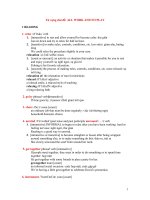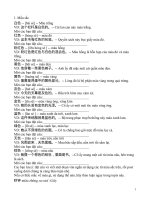Toeic theo chủ đề 9 pot
Bạn đang xem bản rút gọn của tài liệu. Xem và tải ngay bản đầy đủ của tài liệu tại đây (65.95 KB, 6 trang )
32 TOEFL EXAM ESSENTIALS
d. When the immune system breaks down, it can be dev-
astating.
Choice c is correct—it gives the main idea or point that the
instructor is trying to express. It’s a general statement that
holds together all of the information in the passage. Choice
a is too specific to be the main idea. Choice b is too general
to be the main idea. Choice d may be true, but the passage
does not give this information.
2. Find the supporting details. Supporting details are
facts or specific examples that give proof of a speaker’s
main idea. The next question asks you to find a
supporting detail from the mini-lecture about the
immune system.
Question: The body’s immune system consists of
a. swarming bees
b. billions of cells
c. a complex organization
d. a communication network
The correct answer is b. You can easily eliminate choice a—
it’s a silly answer choice used to distract you. Choices c and
d are too general to be supporting details.
Supporting detail: a specific fact or example that supports
the main idea
LISTENING 33
3. Make inferences. Often people do not say what they
mean in explicit terms. In these cases, you need draw a
logical conclusion based on details or from what is
suggested in a conversation. In the listening test, some
questions ask you to make inferences based on a
speaker’s tone, or attitude about his or her subject.
Man 1: How about you help me fix my car today?
Man 2: Sure, Sam. Right after I go to work, go to the game,
and study!
Question: What does Man 2’s reply suggest?
a. He plans on helping Sam fix his car.
b. He doesn’t have time to help Sam today.
c. He will help Sam, if Sam does his homework for him.
d. He is promising to help.
Choice b is correct. In speech, people often use tone rather
than words to convey meaning. A word like “sure” can have
dozens of meanings depending on the speaker’s tone. Dur-
ing the exam, listen to how someone speaks. Consider the
speaker’s attitude or mood: is he or she expressing joy, anger,
disbelief, or another emotion?
Inference questions may also ask you to draw a conclu-
sion based on what a speaker implies or assumes. Here is an
example:
Tone: a speaker’s mood or attitude expressed in speech
34 TOEFL EXAM ESSENTIALS
Woman: Frank, how do I get to Times Square?
Frank: Ask Sarah. She’s a native New Yorker.
Question: What is Frank assuming about Sarah?
a. She always carries a map of New York City.
b. She doesn’t know how to get to Times Square.
c. She will know how to get to Times Square because she
grew up in New York.
d. Frank doesn’t know how to get to Times Square.
Choice c is correct. Choice a may be true, but it is not what
Frank is implying. Choice d may be true, but it doesn’t answer
the question.
The last type of inference question asks you to make a log-
ical conclusion about what the speaker will do in the future
based on the conversation:
Woman: I forgot my textbook. Professor Jacob said we
could look at our books during the test.
Man: I have a copy that I’m not using.
Question: What will the woman probably do?
a. Borrow the man’s textbook for the test.
b. Go home so she can get her book.
c. Ask the professor if she can take the test another day.
d. Call home and see if her roommate will bring it to her.
Choice a is correct. The man is offering his book to the
woman even though he is not saying it explicitly. You can make
this conclusion based on what he is suggesting.
LISTENING 35
OTHER QUESTION TYPES ON THE COMPUTER TEST
Most of the questions on the computer-based test are traditional
multiple choice, but some are types that can only be used on a
computer. If you are taking the computer-based TOEFL exam,
become familiar with these question types:
■
Questions with more than one answer. You will select
two of four possible answer choices. Here is an example:
Acid rain looks, feels, even tastes like clean rainwater, but it
actually contains high levels of pollutants. Although natural
sources like gases from forest fires can be part of the problem,
the burning of fossil fuels, such as car exhaust and smoke from
factories, is the main cause of acid rain. This how it works: pol-
lutants mix in the atmosphere to form fine particles that can
be carried long distances by wind. Eventually, they return to
the ground in the form of rain or other precipitation. Acid rain
has caused widespread damage in eastern North America,
Europe, Japan, China, and Southeast Asia.
Question: Based on the lecture, which of the following can
cause acid rain?
[Click on two answers.]
a. contaminated drinking water
b. natural sources
c. man-made pollutants
d. rain
Answer: b and c.
■
Questions that use visual information. You will select
an image or part of an image for your answer.
36 TOEFL EXAM ESSENTIALS
Question: Choose the map that best represents the areas
negatively affected by acid rain. [Click on a map.]
Answer: You would choose a map that highlights eastern
North America, Europe, Japan, China, and Southeast Asia.
■
Sequence questions. You will put information or
events into order so that they form a process.
Question: Summarize what happens to acid-rain pollutants
by placing the stages in the proper order. [Click on a word.
Then click on the space below where it belongs. Use each
word only once.]
form fine particles carried by wind mix in atmosphere
return to ground in rain
1. _____________________________________________
2. _____________________________________________
3. _____________________________________________
4. _____________________________________________
Answer: 1. mix in atmosphere; 2. form fine particles; 3.
carried by wind; 4. return to ground in rain.
■
Matching questions. You will match up or pair images,
words, or phrases.
LISTENING 37
Question: An instructor describes the formation and effects
of acid rain. Match each term with its definition.
[Click on a sentence. Then click on the space where it
belongs. Use each sentence only once.]
precipitation fossil fuel pollutant
something that contaminates the environment
condensed vapor that falls to earth as a deposit like rain or snow
a fuel formed in the earth from plant or animal remains
Answer:
precipitation fossil fuel pollutant
condensed vapor a fuel formed in something that
that falls to earth the earth from contaminates the
as a deposit like plant or animal environment
rain or snow remains
WHAT’S UP WITH IDIOMATIC EXPRESSIONS
You probably won’t see the greeting “What’s up?” in the reading
portion of the TOEFL exam, but you might hear it—or another
idiom—on the listening test. Idioms are words or phrases used
in a particular region. Idiomatic expressions often have unusual
grammatical structures or have a meaning that does not make sense
when you add up the meanings of each word. Here’s an example
of a test question that will ask you to identify the meaning of an
idiomatic expression:
Woman: The astronomy midterm is tomorrow!
Man: I know. I’m not ready. It’s going to be an all-nighter!









